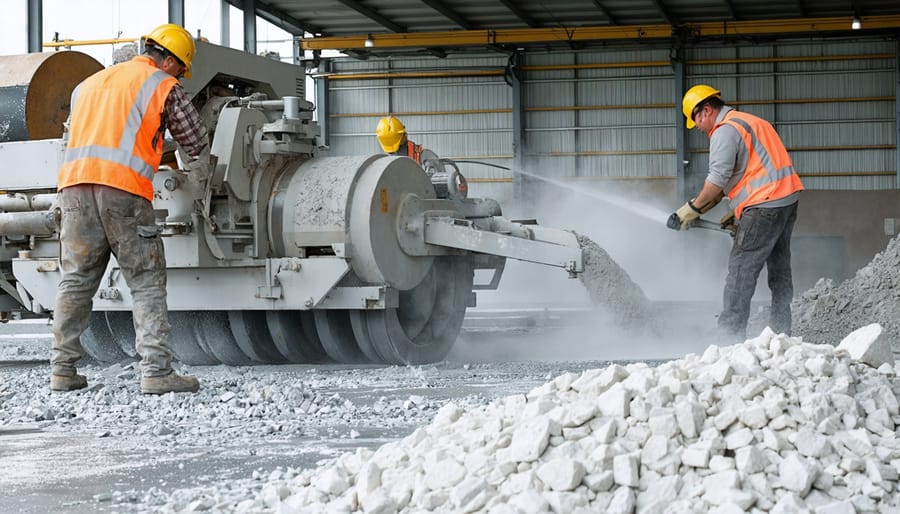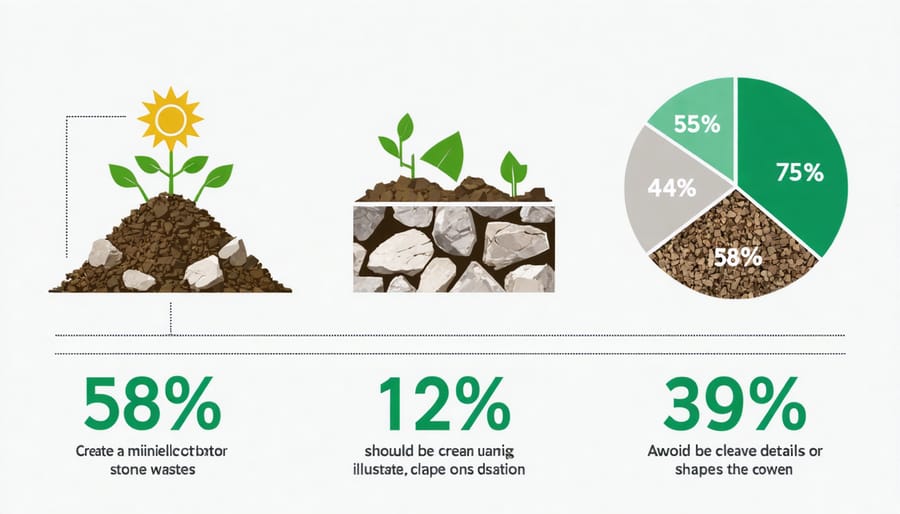Stone waste stands as one of the construction industry’s most significant yet overlooked challenges, generating millions of tons of debris annually from quarrying, processing, and construction activities. This byproduct of our built environment encompasses everything from marble dust and granite chips to limestone remnants and slate fragments – materials that once represented valuable natural resources.
As sustainability becomes increasingly crucial in construction practices, understanding stone waste has never been more important. The material ranges from microscopic particles produced during cutting and polishing to substantial blocks discarded due to imperfections or sizing issues. These remnants, despite their perceived worthlessness, hold untapped potential for recycling, repurposing, and innovative applications in sustainable construction.
In an era where circular economy principles drive industry innovation, stone waste represents both an environmental challenge and an opportunity. Its proper management and utilization can significantly reduce construction’s environmental footprint while opening new avenues for resource efficiency and cost savings.
What Constitutes Stone Waste in Construction
Production Waste
Production waste in the stone industry primarily occurs during quarrying operations and initial processing stages. During extraction, approximately 40-60% of the quarried stone becomes waste in the form of irregular blocks, chips, and stone powder. This waste is generated through various processes including drilling, cutting, blasting, and sawing of stone blocks.
The primary sources of production waste include overburden removal, where top layers of soil and unsuitable stone are cleared, and dimensional stone cutting, where large blocks are shaped into commercial sizes. During processing, activities such as grinding, polishing, and edge cutting contribute to additional waste generation through stone slurry and fine particles.
Modern quarrying techniques and advanced cutting technologies have helped reduce waste generation, but significant amounts still accumulate. For instance, diamond wire saws, while more efficient than traditional methods, still produce considerable amounts of stone dust and small fragments. This production waste varies by stone type, with harder stones like granite typically generating more waste during processing than softer stones like limestone.
The management of this waste at the production site is crucial, as improper handling can lead to environmental issues and lost economic opportunities.
Processing Waste
During stone processing operations, significant waste is generated at various stages of production. The primary sources include sawing, where large blocks are cut into slabs using gang saws or wire saws, producing stone slurry and particles. Shaping and edging processes create smaller stone fragments and dust, while polishing and finishing generate fine particulate matter and residual slurry.
A typical stone processing facility can generate between 15-40% of the original stone block as waste material. This includes both solid waste in the form of stone pieces, chips, and powder, as well as liquid waste containing water mixed with stone particles and abrasive materials used in cutting and polishing.
The waste generated varies depending on the type of stone being processed, the equipment used, and the specific finishing requirements. For example, granite processing typically produces more waste than marble due to its harder composition and the additional processing steps required. Modern facilities employ water recycling systems and dust collection mechanisms to minimize waste and capture potentially reusable materials, though significant quantities still require proper disposal or alternative applications.
Sources of Stone Waste
Quarrying Operations
During quarrying operations, a significant amount of stone waste is generated as part of the natural stone construction process. This waste primarily occurs during the extraction of stone blocks from the quarry face, where large portions of rock are removed but not all material meets quality standards for commercial use. Common forms of quarrying waste include irregular blocks, stone fragments, and overburden material removed to access viable stone deposits.
The extraction process typically involves drilling, cutting, and blasting techniques, each generating different types of waste. Overburden waste consists of soil and weathered rock that must be cleared before reaching quality stone. During block cutting, the irregular shapes and sizes that don’t meet dimensional requirements become waste material. Additionally, natural fissures, cracks, and variations in stone quality can render portions of extracted material unsuitable for commercial applications, contributing to the overall waste volume at quarry sites.

Fabrication Process
The fabrication process of natural stone generates significant waste during cutting, shaping, and finishing operations. When blocks of raw stone are cut into slabs or tiles, approximately 30% of the material becomes waste in the form of stone dust, chips, and irregular pieces. Diamond-tipped saws and wire cutters create fine stone powder during cutting, while shaping and edging processes produce larger stone fragments.
Modern stone processing facilities use wet cutting methods to minimize dust dispersal, resulting in stone slurry – a mixture of stone particles and water. This slurry must be properly managed and treated before disposal. Additionally, when fabricators shape custom pieces or create intricate designs, the trimming and finishing steps generate offcuts that are too small or irregular for standard use.
The amount of waste produced varies depending on factors like stone type, cutting equipment efficiency, and fabrication requirements. For example, granite typically produces more waste during processing than softer stones like marble due to its harder composition and specific cutting needs. Advanced CNC machinery and optimized cutting patterns help reduce waste, but some material loss is inherent to the fabrication process.

On-Site Construction
During on-site construction, stone waste is generated through various installation activities and adjustments. Common sources include cutting stones to size, drilling holes for fixtures, and making modifications to accommodate architectural features or utilities. When installers trim large stone slabs or blocks to fit specific dimensions, the excess material becomes waste. Additionally, breakage during handling, incorrect measurements, and last-minute design changes can result in significant stone waste.
Some waste is created during the finishing process, such as grinding, honing, or polishing stone surfaces on-site. These processes generate stone dust and small particles that must be properly contained and disposed of. Installation errors, such as improper cutting or misaligned pieces, may also result in otherwise usable stone becoming waste material.
To minimize on-site waste, contractors typically employ precise measurements, use specialized cutting tools, and implement careful handling procedures. Pre-planning and accurate material calculations are essential for reducing excess material and maximizing stone utilization during installation.

Environmental Impact
Land Use Issues
Stone waste disposal presents significant challenges for land use management, particularly in regions with active quarrying and stone processing operations. Large-scale stone waste deposits can occupy extensive areas of valuable land that could otherwise be used for agriculture, housing, or conservation purposes. These disposal sites, often characterized by massive piles of stone fragments and powder, can permanently alter the natural landscape and topography of an area.
The visual impact of stone waste dumps can be particularly concerning in scenic locations, affecting both tourism potential and local property values. Moreover, these sites require careful planning and management to prevent soil contamination and ensure proper drainage. Without proper containment, stone waste particles can spread to surrounding areas through wind and water erosion.
Many quarries and processing facilities struggle with limited disposal space, leading to the creation of ever-expanding waste yards. This continuous expansion puts pressure on local ecosystems and creates long-term land management challenges. Some regions have implemented strict regulations requiring rehabilitation plans for waste disposal areas, including measures for eventual land reclamation and restoration to more productive uses.
Resource Depletion
The extraction of natural stone for construction and architectural purposes raises significant resource depletion concerns that cannot be ignored. Unlike renewable materials, natural stone takes millions of years to form, making it essentially non-renewable on a human timescale. Current quarrying rates often exceed the stone’s natural formation process, leading to the permanent loss of these valuable geological resources.
Many quarries worldwide are facing diminishing reserves, particularly for high-quality stone varieties that are in greatest demand. This depletion not only affects the availability of premium stone materials but also impacts local ecosystems and geological heritage. The situation is particularly critical in regions where specific stone types are unique to the area and cannot be sourced elsewhere.
To address these sustainability challenges, the industry is increasingly focusing on maximizing resource efficiency through improved quarrying techniques, better waste management, and the use of stone waste in alternative applications. Some companies are also exploring ways to incorporate recycled stone materials into new products, helping to extend the lifespan of existing stone resources and reduce the pressure on natural deposits.
Economic Implications
Stone waste management has significant financial implications for construction projects and the natural stone industry. The disposal of stone waste typically accounts for 15-20% of total project costs, making it a crucial consideration for project budgeting and planning. Companies that effectively manage their stone waste can reduce these expenses through various cost-saving measures.
Recycling and repurposing stone waste can generate additional revenue streams. Crushed stone waste can be sold as aggregate for concrete production, landscaping materials, or road base construction, offsetting disposal costs. Some manufacturers have successfully marketed stone waste products at 40-60% of virgin material prices, creating a profitable secondary market.
The economic impact extends beyond direct costs. Proper stone waste management can lead to reduced transportation expenses, lower landfill fees, and decreased raw material purchases. Companies implementing efficient waste management systems often report 25-30% savings in overall material costs.
However, initial investments in stone waste processing equipment and storage facilities can be substantial. These costs typically include crushing machines, sorting systems, and dedicated storage areas. Despite these upfront expenses, most companies achieve return on investment within 2-3 years through reduced waste disposal costs and revenue from recycled products.
Additionally, businesses that demonstrate effective stone waste management often gain competitive advantages through improved sustainability credentials, leading to increased project opportunities and better client relationships.
Stone waste management represents a critical aspect of sustainable construction practices that cannot be overlooked. Throughout this article, we’ve explored how stone waste encompasses various materials generated during quarrying, processing, and construction activities. From marble and granite residues to limestone dust, proper handling of these byproducts is essential for both environmental protection and economic efficiency.
The impact of stone waste extends beyond simple disposal concerns, affecting air quality, water resources, and local ecosystems. However, we’ve also seen how innovative approaches to waste management can transform these challenges into opportunities. Through recycling and repurposing initiatives, stone waste can find new life in construction materials, landscaping applications, and even artistic endeavors.
As the construction industry continues to evolve toward more sustainable practices, proper stone waste management becomes increasingly important. By implementing effective waste reduction strategies, utilizing modern processing techniques, and exploring creative reuse options, we can significantly minimize environmental impact while maximizing resource efficiency. The future of construction depends on our ability to balance development needs with environmental responsibility, making stone waste management an essential consideration for industry professionals and stakeholders alike.










